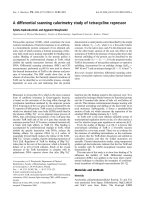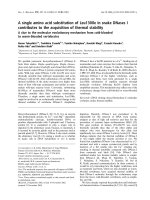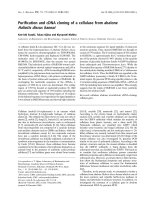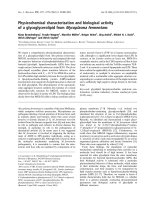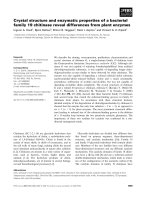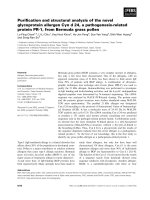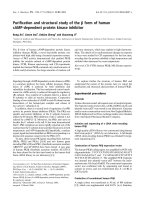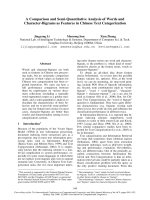Báo cáo khoa học: " A morphological and molecular study of Anaplasma phagocytophilum transmission events at the time of Ixodes ricinus tick bite" pps
Bạn đang xem bản rút gọn của tài liệu. Xem và tải ngay bản đầy đủ của tài liệu tại đây (1012.74 KB, 7 trang )
Granquist et al. Acta Veterinaria Scandinavica 2010, 52:43
/>Open Access
RESEARCH
© 2010 Granquist et al; licensee BioMed Central Ltd. This is an Open Access article distributed under the terms of the Creative Commons
Attribution License ( which permits unrestricted use, distribution, and reproduction in
any medium, provided the original work is properly cited.
Research
A morphological and molecular study of
Anaplasma phagocytophilum
transmission events
at the time of
Ixodes ricinus
tick bite
Erik G Granquist*
1
, Mona Aleksandersen
2
, Karin Bergström
3
, Stephen J Dumler
4
, Wenche O Torsteinbø
1
and
Snorre Stuen
1
Abstract
Background: Anaplasma phagocytophilum is the causative agent of human granulocytic anaplasmosis (HGA) in
humans and tick-borne fever (TBF) in ruminants. The bacterium invades and replicates in phagocytes, especially in
polymorphonuclear granulocytes.
Methods: In the present study, skin biopsies and ticks (Ixodes ricinus) were collected from tick feeding lesions on 38
grazing lambs between two and three weeks after access to pastures. The histopathological changes associated with
tick bites and A. phagocytophilum infection, were described. In addition the skin biopsies were examined by
immunohistochemistry. Furthermore, samples from blood, skin biopsies and ticks were examined by serology, PCR
amplification of msp2 (p44), genotyping of rrs (16S rRNA) variants, and compared with the results obtained from
histological and immunohistochemical investigations.
Results: Tick bites were associated with chronic and hyperplastic inflammatory skin lesions in this study. A.
phagocytophilum present in skin lesions were mainly associated with neutrophils and macrophages. Bacteria were
occasionally observed in the Tunica media and Tunica adventitia of small vessels, but were rarely found in association
with endothelial cells. PCR and genotyping of organisms present in blood, ticks and skin biopsies suggested a
haematogenous and a local spread of organisms at the tick attachment sites.
Conclusions: The present study describes different aspects of A. phagocytophilum infection at the site of tick bite, and
indicates that A. phagocytophilum rarely associates with endothelium during the early pathogenesis of infection.
Introduction
Anaplasma phagocytophilum is recognized as the caus-
ative agent of Human Granulocytic Anaplasmosis (HGA)
in humans and tick-borne fever (TBF) in ruminants [1-3].
Although self-limiting in sheep, immune suppression
with infection often results in secondary infections that
complicate the clinical picture [4]. TBF is of growing con-
cern from the production and animal welfare perspec-
tives in the sheep industry [5].
A. phagocytophilum is known to primarily infect and
propagate in polymorphonuclear leucocytes (PMN) [6-8].
Its strict intracellular location provides a mechanism for
evading host defences, and also promotes chemotactic
mechanisms (IL-8) that assist the attraction of neutro-
phils to the tick bite site [9]. Degranulation of neutrophils
at the tick bite site increases the permeability of blood
vessels and increases the cellular infiltration of the area
[10,11]. Because of the short-lived nature of circulating
neutrophils, the role of these cells in establishing and
maintaining infection has been questioned [10]. Earlier
studies have suggested that cells other than PMN are
involved in the early pathogenesis, since ticks do not
directly tap the blood vessels and thus cannot directly
deliver pathogens to circulating leukocytes [12-15].
Once inside the host cell however, a closed microenvi-
ronment structurally designed to protect vital processes
within the cell, gives shelter from extracellular humoral
and cellular immune responses [16-20]. Earlier studies in
* Correspondence:
1
Department of Production Animal Clinical Sciences, Section of Small
Ruminant Research, Norwegian School of Veterinary Science, Sandnes, N-4325
Norway
Full list of author information is available at the end of the article
Granquist et al. Acta Veterinaria Scandinavica 2010, 52:43
/>Page 2 of 7
cell culture have shown that endothelial cells are capable
of being infected with A. phagocytophilum and support
infection in vitro [10,15,21].
The rationale of the present study was to examine the
local skin inflammation, created during A. phagocytophi-
lum infection, and if endothelial cells may act as in vivo
host cells for A. phagocytophilum during natural infection
in lambs. Skin biopsies were collected from tick attach-
ment sites and examined by histology, immunohis-
tochemistry, PCR amplification of msp2 (p44) and
genotyping of A. phagocytophilum by PCR amplification
and sequencing of rrs (16S rRNA gene). Blood samples
were also examined for the presence of bacteraemia by
PCR amplification and rrs (16S rRNA gene) genotyping
of A. phagocytophilum in addition to indirect fluores-
cence antibody test (IFAT).
Materials and methods
Animals and sampling
Skin biopsies, EDTA blood and serum samples from 38
lambs of the Norwegian White breed from two flocks
were collected in May and June of the 2006 and 2007
grazing seasons, in the Rogaland and Vest-Agder county
of Norway, respectively. The lambs were 4-6 weeks old
and the samples were collected between two and three
weeks after the lambs were put to pastures that were pre-
viously known to be heavily infested with the sheep tick
(Ixodes ricinus). The individual animals were selected for
sampling based on the presence of at least two fresh tick
bites. In addition, the rectal temperature was measured as
an indicator of acute tick-borne fever [22]. If ticks were
still attached, they were collected and stored unfixed on
individual plastic tubes for later PCR amplification of
msp2 (p44) to determine if they were infected by A.
phagocytophilum. The wool in the tick bite area was
sheared, and the skin surface was disinfected by 70% eth-
anol, before a subcutaneous ring block of local anaesthe-
sia was laid around the tick bite (0.5-1.0 ml 2%
Carbocain™, AstraZeneca). A punch biopsy knife (8 mm
in diameter) was used for collection of the skin biopsies
[23]. Two biopsies from the tick bite sites and one control
biopsy at least 20 cm from other ticks or tick bites were
collected from each lamb.
The biopsy wounds were closed by agraffe sutures. The
skin biopsies were cut in two halves with sterile scalpels.
One half was stored on Zamboni's fixative before histo-
logical processing and the other was kept on ice until fro-
zen at -80°C for later DNA isolation. The experiment was
approved by the National Animal Research Authority in
Norway.
Real time PCR for identification of positive samples,
targeting msp2 (p44)
DNA was isolated from EDTA blood and skin biopsies,
using a DNeasy
®
Blood and Tissue kit (Qiagen GmbH,
Hilden, Germany) according to protocols provided by the
DNeasy
®
Blood and Tissue Handbook (2006). DNA from
ticks was isolated using the DNeasy
®
Tissue kit (QIAGEN)
for isolation from insects, according to protocols pro-
vided by the DNeasy
®
Tissue kit Handbook (2004), with
modifications as follows; The volume of Proteinase K was
doubled and the incubation time with Proteinase K was
extended to be 24 hours. The isolated DNA was diluted
according to spectrum readings and final template vol-
ume was 5 μl containing 2.5 ng/μl total DNA. PCR posi-
tive samples were detected by Real Time PCR using the
Lightcycler
®
480 (LC480) (Roche Diagnostics Meylan,
France) with Fast Start MASTER
PLUS
SYBR-green I Taq
polymerase mix and fluorescence detection. The specific
primers (Apmsp2f: 5'-ATG GAA GGT AGT GTT GGT
TAT GGT ATT-3'and Apmsp2r: 5'-TTG GTC TTG AAG
CGC TCG TA-3') were designed to amplify a 77 bp seg-
ment at the conserved N-terminal coding region of msp2
(p44)in the A. phagocytophilum genome [24]. Crossing
points (CP) were determined by using the 2
nd
derivative
maximum method of the LightCycler
®
Software 1.5.0
(Roche Diagnostics). The Cq (treshold cycle) was set to
be 40 since rrs (16S rRNA gene) sequences (see below)
were obtained from two tissues having CP values of 39
and 40, respectively. Further validation of msp2 (p44)
amplicons was determined by melting point (Tm) analy-
sis (range 82°C-83°C).
Semi nested conventional PCR and sequencing of the 16S
rRNA gene
DNA from blood and tissues were extracted according to
the protocols described in the above section. A semi-
nested PCR was conducted for amplification of rrs (16S
rRNA gene) on a PTC-200 instrument (MJ Research) as
previously described [25]. Briefly, an initial PCR was per-
formed using primers 16S-F5 (5'-AGTTTGATCATGGT-
TCAGA-3') and ANA-R4B (5'-CGAACAACGCTTGC-
3') for amplification of a 507 bp fragment of rrs (16S
rRNA gene) in A. phagocytophilum, followed by a semi-
nested reaction with primers 16S-F5 and ANA-R5 (5'-
TCCTCTCAGACCAGCTATA-3') that produced a 282
bp fragment. Positive amplification was verified by aga-
rose gel electrophoresis and amplified PCR products
were sequenced directly, using Big Dye terminator cycle
sequencing chemistry and capillary electrophoresis (ABI
310; Applied Biosystems). A. phagocytophilum variants
were detected from visual inspection of the chromato-
grams [25].
Haematology
Differential blood cell counts were performed on EDTA
blood samples using the Advia 120 Automated Hematol-
ogy Analyzer (Bayer Corporation, Tarrytown, NY, USA)
for evaluation of neutropenia (< 0.7 × 10
9
cells/L).
Granquist et al. Acta Veterinaria Scandinavica 2010, 52:43
/>Page 3 of 7
Serology
An indirect immunofluorescence antibody assay (IFA)
was used to determine the polyvalent antibody titres to A.
phagocytophilum. Briefly, two-fold dilutions of sera were
added to slides precoated with antigen obtained from
horses (formerly Ehrlichia equi) (Protatek, St. Paul.
Minn., USA). Bound antibodies were visualized by fluo-
rescein-isothiocyanate (FITC)-conjugated rabbit-anti-
sheep immunoglobulin (Cappel, Organon Teknika, West
Chester, PA, USA). Sera were screened for antibodies at
dilution 1:40. If positive, the sera were further diluted and
retested. A titre of 1.6 (log
10
reciprocal of 40) or more was
regarded as positive [26].
Histology and immunohistochemistry
Skin samples fixed in Zamboni's fixative were routinely
processed and embedded in paraffin. Tissue sections of 3
μm thickness were sectioned parallel to the tick bite and
stained with haematoxylin and eosin for histological
examination.
For immunohistochemistry (IHC), 3 μm thick sections
were collected on Menzel-Gläser SuperFrost Ultra Plus
®
slides (Braunschweig, Germany) and dried over night at
37°C. The sections were deparaffinised in xylene and
rehydrated in graded alcohol solutions. The sections were
treated with 0.1M citrate buffer (pH 6.0) at 92°C for 20
minutes in water bath or microwave oven for antigen
retrieval and then cooled at room temperature for 30
minutes. After washing in distilled water, slides were
placed in phosphate buffered saline (PBS) for equilibra-
tion. Endogenous peroxidase activity was inhibited by
application of a methanol solution containing 1% H
2
O
2
for 10 minutes, followed by washing in PBS and incuba-
tion for 20 minutes at room temperature with normal
blocking serum (VECTASTAIN
®
Elite kit) (Vector Labo-
ratories, Burlingham, CA, USA), diluted 1:50 in PBS con-
taining 5% bovine serum albumin (BSA/PBS).
The sections were incubated with either a monoclonal
anti A. phagocytophilum antibody or a polyclonal rabbit
anti A. phagocytophilum antibody. The primary antibod-
ies were diluted 1:400 in 1% BSA/PBS and incubation was
over night at 4°C. After washing in PBS, the sections were
incubated with the biotinylated universal antibody from
the kit according to the protocol provided by the pro-
ducer (VECTASTAIN). The sections were further incu-
bated for 30 minutes with the VECTASTAIN
®
Elite ABC
reagent after washing. Sections were exposed for the 3-
amino-9-ethyl carbazole substrate (AEC) for 15 minutes
and counterstained with non-alcoholic haematoxylin.
Slides were washed three times in sterile water and
mounted with poly vinyl alcohol (PVA).
Results
Examination of the animals
Twenty-three of 38 lambs (60.5%) had rectal tempera-
tures above 40°C and the highest recorded temperature
was 41.5°C. Thirteen lambs (34.2%) had neutropenia at
the time of sampling and nine lambs (23.7%) had fever
and neutropenia. The number of engorged ticks on the
animals varied from one to more than 30 at the time of
sampling. Skin biopsies were mostly collected from the
axillary and inguinal regions as they were the most fre-
quent tick attachment sites, registered. Tick bite sites
showed typical mild erythema and local swelling.
PCR amplification of A. phagocytophilum msp2/p44 in
blood, skin biopsies and ticks
Thirty-three lambs (86.8%) were positive for A. phagocy-
tophilum by PCR analysis of peripheral blood. Thirty-
seven (97.4%) had one or more skin biopsies that were
positive for A. phagocytophilum by PCR analysis. Seventy
of 76 biopsies from tick attachment sites (92.1%) and 31
of 38 control biopsies (81.5%) were positive by PCR for A.
phagocytophilum infection. A total of 68 ticks were col-
lected from the lambs. Fifty-eight (85.3%) were positive
for A. phagocytophilum by PCR. Two PCR positive ticks
(2.9%) had a negative attachment site.
Sequencing of rrs (16S rRNA gene)
Six different rrs (16S rRNA gene) isolates of A. phagocyto-
philum were encountered during the study, that were
similar to GenBank acc. no. U02521
, M73220, AF336220,
AY035312
, AJ242784, and a novel variant GU459257. All
variants except AY035312
were collected from the flock
in Vest-Agder county. The variants M73220
, AJ242784
and AY035312 were collected from the flock in Rogaland
county. A total of 38 partial rrs variant sequences were
obtained from the tick bite biopsies. Nineteen of 38
sequences (50.0%) obtained from tick bite sites corre-
sponded to the sequences obtained from the respective
ticks. The sequences obtained from control biopsies and
the blood samples were identical in all lambs where both
sequences were obtained (N = 10) (data not shown). No
direct relations between variants, serum titre and inflam-
matory changes were observed.
Histology
Histological examination of biopsies from infected skin
areas showed inflammatory lesions in 35 of the 38 lambs
(92.1%). The majority of lambs (60.5%) had focal histo-
pathologic changes, characterized by thickened epider-
mis, dermal fibroplasia and perivascular to diffuse
infiltration of mixed leucocytes (Fig. 1a). Twelve lambs
(31.6%) had milder changes with perivascular inflamma-
tory cell infiltration in affected areas, whereas histo-
pathological changes were not observed in three of the
lambs. Focal ulcerations of the epidermis were observed
in skin biopsies from 10 (26.3%) animals (Fig. 1a). The
inflammatory exudate was composed of numerous neu-
trophils and eosinophils in addition to mast cells, lym-
phocytes and macrophages (Fig. 1b). The perivascular
aggregates were mainly composed of mononuclear
inflammatory cells. A substantial number of lambs, 14
Granquist et al. Acta Veterinaria Scandinavica 2010, 52:43
/>Page 4 of 7
out of 38, showed cellulitis with subcutaneous infiltration
of neutrophils. Other lesions such as focal degeneration
of dermal collagen (18.4%), vasculitis (10.5%), thrombosis
of venules and lymphatics (15.8%) were observed (Fig 1c).
The different rrs (16S rRNA gene) variants of A. phago-
cytophilum seemed to produce similar pathological
lesions. The control biopsies did not show inflammatory
changes.
Immunohistochemical examination, PCR and serology
Variable numbers of IHC positive organisms were
observed in tick bite biopsies from 17/38 lambs (44.7%)
and appeared as intracytoplasmic aggregates, known as
morulae. The observed organisms were associated with
leucocytes in the inflammatory infiltrate in the biopsies
and were most often present in neutrophils or mac-
rophages (Fig. 2b). In addition IHC positive organisms
were occasionally observed in an extracellular location,
either in the lumina of blood vessels or in the adventitial
tunic. Bacteria were occasionally located in cells infiltrat-
ing the vascular walls of venules or arterioles, usually in
Tunica media or Tunica adventitia and rarely in Tunica
intima (Fig. 2a). A. phagocytophilum organisms were also
present in intravascular inflammatory cells in lambs
showing vasculitis (Fig. 2a). IHC positive organisms were
sometimes observed close to the vessel lumina (Fig. 2b).
There was a large variation in the number of IHC positive
A. phagocytophilum organisms, observed in biopsies
between animals, and in different biopsies from the same
animal (data not shown). Some biopsies had scattered
IHC positive labeling whereas intensively stained aggre-
gates were observed in other lambs. Intensively stained
aggregates were mostly observed among inflammatory
cell infiltrates of the dermis and subcutis. The control
biopsies were IHC negative for A. phagocytophilum.
All lambs with IHC positive skin biopsies were also
positive for msp2 (p44) by PCR on blood samples and
were seropositive for A. phagocytophilum infection. The
serological examination gave the best measures of time
post infection. Three lambs were seronegative (titre < 40)
and had no visible organisms in the skin biopsies exam-
ined by immunohistochemistry. Table 1 shows that 20
(80%) of 25 IHC positive skin biopsies were collected
from animals with a serum titer ranging from 40 to 1280.
Only 5 (20%) of the IHC positive biopsies were collected
from the group having titers ranging from 2560 to 5120
(Table 1).
Discussion
Local infection with A. phagocytophilum in tick attach-
ment sites of lambs were characterized by hyperplastic
skin changes and inflammatory infiltrates, similar to what
Figure 1 Skin lesions in lambs naturally infected with A. phagocy-
tophilum. a) Skin biopsy with an attached tick (arrow) and ulceration
of epidermis. Inflammatory cell infiltrates are present in dermis and
subcutis underneath the tick bite. [Haematoxylin and eosin. Bar = 300
μm.]
b) Photomicrograph of dermis. Thrombi (t) are present in lymphatics
and venules, and a focal necrosis is observed in the wall of an artery (a).
Infiltration of leukocytes, moderate oedema and proliferation of fi-
brous tissue is found in dermis. [Haematoxylin and eosin. Bar = 100
μm.]
c) Photomicrograph of dermis. A large thrombus is occluding the lu-
men of a vein (arrows). Infiltration of neutrophils, macrophages and
lymphocytes are present in dermis. [Haematoxylin and eosin. Bar = 50
μm.]
Granquist et al. Acta Veterinaria Scandinavica 2010, 52:43
/>Page 5 of 7
is described for tick bite reactions even in the absence of
A. phagocytophilum infection. Immunohistochemistry
showed the presence of A. phagocytophilum in approxi-
mately 45% of the lambs. These lambs were also positive
for A. phagocytophilum by PCR on blood and skin biop-
sies. A. phagocytophilum organisms were mainly found in
inflammatory cell infiltrates, particularly in PMNs and
macrophages of the dermis and subcutis. In the present
study, microorganisms were rarely observed in leucocytes
in the blood stream of the skin biopsies, whereas Lepidi
and coworkers reported that approximately 90% of the
infected neutrophils in deep tissues from sheep, humans
and horses were seen within vessel lumens [9]. IHC posi-
tive organisms were sometimes observed in the mid- and
peripheral part of the vessel walls, but rarely in the inti-
mal layer in the present study. The endothelium has ear-
lier been suggested to function as a transition site for
transfer of A. phagocytophilum to neutrophils that are
loosely bound and then released into the blood stream
[15]. The present study however indicates that endothe-
lium infection is a rare finding and it does not support the
role of endothelium in the pathogenesis of A. phagocyto-
philum infection in lambs, at least at the earliest phases of
tick bite inoculation. This stands in contrast to studies
reported in mice, for which no morphological images are
available [10]. The current study is however, limited in
that it is not an experimental study. The field conditions
did neither allow control with attached ticks and infec-
tious organisms, nor a longitudinal study of skin lesions,
which is best estimated, based upon serum antibody titer,
and at this point, endothelium could have played a role.
The very low number (7.9 %) of sero-negative animals
(titre < 40), all which were IHC-negative, indicated that
most lambs were sampled after seroconversion. Most of
the IHC positive skin biopsies were collected from ani-
mals with serum titres between 40 and 1280, which may
indicate that these had acute infections. However, pres-
ence of maternal immunity cannot be neglected, since the
half life of maternal antibodies has been estimated to be
17.5 days [27]. Animals with titres between 2560 to 5120,
were likely to have seroconverted. The IHC-positive
organisms, observed in biopsies from this latter group,
may therefore have been associated with an acute infec-
tion.
PCR detection of msp2 (p44) in blood samples showed
that at least 86.8 % of the lambs, had A. phagocytophilum
bacteraemia at the time of sampling. Five rrs (16S rRNA
gene) variants were encountered. Organisms in biopsies
with sequences obtained from variants U02521
, M73220,
AF336220
and AJ242784 were detected by IHC. Differ-
ences in local inflammatory responses to these variants
have never been described, but previous studies have
shown that different rrs (16S rRNA gene) variants of A.
phagocytophilum can result in different immunological
responses and clinical reactions [28]. However, in the
present study, no direct relationship between gene vari-
ants, serum titre or inflammatory changes were observed.
Similar histopathologic findings and inflammatory infil-
trates with monocytes and neutrophils were associated
with all rrs (16S rRNA gene) variants.
Nineteen of 38 sequences (50.0 %) obtained from tick
bite sites corresponded to the sequences obtained from
the respective ticks. All variants, except GU459257
(iso-
lated from the skin and blood) have previously been iso-
lated from the blood of infected sheep. The sequences
obtained from control biopsies and the blood samples
however were identical in all lambs, where both
sequences were obtained, indicating a haematogenous
spread of organisms to the skin. In addition, two PCR
positive control biopsies were collected from animals
having PCR negative blood, indicating that the organisms
Figure 2 Immunohistochemistry for Anaplasma phagocytophi-
lum on skin tissue in lambs naturally infected with A. phagocyto-
philum. a) Intracellular Anaplasma organisms (arrows) are present in
the lumen of a small vessel. Vasculitis characterised by thickened wall
and infiltration of numerous leukocytes is present in this vessel. A few
bacteria are observed in the vessel wall, whereas more Anaplasma or-
ganisms are found in leukocytes in dermis. [Msp2 (P44) immunostain,
original magnification, ×1000]. b) Numerous Anaplasma organisms (ar-
rows) are found in neutrophils and macrophages infiltrating the der-
mis. [Msp2 (P44) immunostain, original magnification, ×1000]
Granquist et al. Acta Veterinaria Scandinavica 2010, 52:43
/>Page 6 of 7
may have originated from nearby tick bites or from
another infected area due to local dissemination. How-
ever, no tick bites were observed within a 20 cm distance
from the control biopsies. The reason for these PCR posi-
tive control biopsies should be further elucidated as this
could comprise a nidus among animals, capable of sus-
taining persistent infection. Future studies should investi-
gate the extent of cell-to-cell infection in the skin, and
how far the infected cells may migrate locally away from
tick bites.
Long-term survival in the skin could function as a res-
ervoir during persistent infection and could be a source
of transmission to other feeding ticks even in the absence
of sustained bacteremia. A previous study reported that
the presence of A. phagocytophilum in the peripheral
blood of small mammals may be short lived and that tis-
sue samples from spleen and ear seemed to be more often
infected than blood [29]. The majority of lambs (60.5%)
had hyperplastic dermatitis with perivascular to diffuse
infiltration of leukocytes. The results also show that the
IHC-positive organisms were associated with the leuko-
cytes of the infiltrate at the tick bite site, indicating that
PMNs and other inflammatory cells are attracted to the
area and may provide a possibility for survival of A.
phagocytophilum beneath the skin surface. However, the
occurrence of persistent skin infections and its role in the
transmission of A. phagocytophilum to ticks has to be fur-
ther investigated.
A positive relationship between the degree of inflam-
mation observed by histology and the number of A.
phagocytophilum organisms detected by IHC, in the same
tissue sections was present. However, quantitative studies
should be performed to further elucidate this, as control
biopsies, also PCR positive for msp2 (p44), did not show
inflammatory changes by histology. Neutrophil infiltra-
tion can be triggered by tick salivary components and
chemotaxins produced by infected neutrophils and other
cell types [30,31]. In addition, the presence of pyogenic
bacteria such as Staphylococcus aureus is commonly
associated with tick bites [32], and will also favor the
attraction of neutrophil granulocytes.
The present study shows that the majority of IHC posi-
tive organisms were present in the inflammatory cell
aggregates. In one animal, rrs (16S rRNA) genotyping of
organisms revealed identical gene variants in the blood
and an IHC-positive biopsy from the same animal that
differed from the gene variant detected in the attached
tick. This indicates that the tick was not the source of
infection, or that the infecting variant selectively survived
in the lamb. In sections where IHC-positive organisms
were detected within the vessel walls, they were usually
observed intracellular in leukocytes. A previous study
reported that more than 95% of infected cells in tissues
were mature neutrophils, based on IHC analysis and that
association of A. phagocytophilum with vessel walls was
rarely observed [9]. However, the direction of migration
of organisms needs further investigation. Lesions such as
vasculitis and thromboses are reported to be rare findings
of A. phagocytophilum infection [9], but were present in
the tick bite wounds of some lambs in the present study.
This may however be caused by tick salivary components
or other pathogens like S. aureus or streptococci that are
likely to be associated with tick bites [32].
In conclusion, whether the endothelium plays a role in
the pathogenesis of and establishment of A. phagocyto-
philum infection at the site of tick bite could not be docu-
mented by the present study. Other factors or cell types,
such as dendritic cells, might be involved, but this was
not examined. Controlled experimental studies with
serial sampling of infected skin are suggested in order to
further elucidate the pathogenesis of this infection during
tick attachment.
Table 1: PCR, Serology and immunohistochemistry on blood, serum and tick bite biopsies, collected from lambs, naturally
infected with A. phagocytophilum
Serum titre ≤ 40 40 - 1280 2560 - 5120 Sum
PCR positive
blood sample
IHC positive 0 20 5 25
IHC negative 1 21 17 39
PCR negative
blood sample
IHC positive000 0
IHC negative260 8
Sum 34722 72
Granquist et al. Acta Veterinaria Scandinavica 2010, 52:43
/>Page 7 of 7
Competing interests
The authors declare that they have no competing interests.
Authors' contributions
EGG performed the sampling, real time PCR, immunohistology, rrs sequence
analysis and writing of the manuscript. MA participated in the design of the
study, performed the histological examination, immunohistological interpreta-
tion and created the figures. MA also revised the draft manuscript. KB per-
formed the IFAT. WOT performed the sequencing of rrs (16S rRNA gene). JSD
participated in the design of the study, provided reagents for IHC and helped
in revising the draft manuscript. SS designed the study and supervised the
writing of the draft manuscript. All authors read and approved the final manu-
script.
Acknowledgements
We thank Dr. Ulrike Munderloh for valuable help and contributions. We also
thank Siri Hamre and Laila Aune for laboratory contributions.
Author Details
1
Department of Production Animal Clinical Sciences, Section of Small
Ruminant Research, Norwegian School of Veterinary Science, Sandnes, N-4325
Norway,
2
Department of Basic Sciences and Aquatic Medicine, Norwegian
School of Veterinary Science, Oslo, N-0033 Norway,
3
National Veterinary
Institute, Uppsala 75189, Sweden and
4
Department of Pathology, Division of
Medical Microbiology, The Johns Hopkins Hospital, Baltimore, MD 21205 USA
References
1. Dumler JS, Madigan JE, Pusterla N, Bakken JS: Ehrlichioses in humans:
epidemiology, clinical presentation, diagnosis, and treatment. Clin
Infect Dis 2007, 45(Suppl 1):S45-51.
2. Bakken JS, Dumler JS, Chen SM, Eckman MR, Van Etta LL, Walker DH:
Human granulocytic ehrlichiosis in the upper Midwest United States. A
new species emerging? JAMA 1994, 272:212-218.
3. Foggie A: Studies on the infectious agent of tick-borne fever in sheep. J
Pathol Bacteriol 1951, 63:1-15.
4. Woldehiwet Z: Immune evasion and immunosuppression by
Anaplasma phagocytophilum, the causative agent of tick-borne fever
of ruminants and human granulocytic anaplasmosis. Vet J 2008,
175:37-44.
5. Stuen S, Bergstrom K, Palmer E: Reduced weight gain due to subclinical
Anaplasma phagocytophilum (formerly Ehrlichia phagocytophila)
infection. Exp Appl Acarol 2002, 28:209-215.
6. Woldehiwet Z: Immune evasion and immunosuppression by
Anaplasma phagocytophilum, the causative agent of tick-borne fever
of ruminants and human granulocytic anaplasmosis. Vet J 2007,
175(1):37-44.
7. Chen SM, Dumler JS, Bakken JS, Walker DH: Identification of a
granulocytotropic Ehrlichia species as the etiologic agent of human
disease. J Clin Microbiol 1994, 32:589-595.
8. Dumler JS, Choi KS, Garcia-Garcia JC, Barat NS, Scorpio DG, Garyu JW, Grab
DJ, Bakken JS: Human granulocytic anaplasmosis and Anaplasma
phagocytophilum. Emerg Infect Dis 2005, 11:1828-1834.
9. Lepidi H, Bunnell JE, Martin ME, Madigan JE, Stuen S, Dumler JS:
Comparative pathology, and immunohistology associated with clinical
illness after Ehrlichia phagocytophila-group infections. Am J Trop Med
Hyg 2000, 62:29-37.
10. Herron MJ, Ericson ME, Kurtti TJ, Munderloh UG: The interactions of
Anaplasma phagocytophilum, endothelial cells, and human
neutrophils. Ann N Y Acad Sci 2005, 1063:374-382.
11. Carlyon JA, Fikrig E: Invasion and survival strategies of Anaplasma
phagocytophilum. Cell Microbiol 2003, 5:743-754.
12. Epperson DE, Pober JS: Antigen-presenting function of human
endothelial cells. Direct activation of resting CD8 T cells. J Immunol
1994, 153:5402-5412.
13. Ferry B, Halttunen J, Leszczynski D, Schellekens H, vd Meide PH, Hayry P:
Impact of class II major histocompatibility complex antigen expression
on the immunogenic potential of isolated rat vascular endothelial
cells. Transplantation 1987, 44:499-503.
14. Udo AK Hetzel, Zerai Woldehiwet: Anaplasma phagocytophilum: Sites of
primary infection. In European Society of Veterinary Pathology 24th
meeting Edinburgh, Scotland; 2006.
15. Munderloh UG, Lynch MJ, Herron MJ, Palmer AT, Kurtti TJ, Nelson RD,
Goodman JL: Infection of endothelial cells with Anaplasma marginale
and A. phagocytophilum. Vet Microbiol 2004, 101:53-64.
16. Niu H, Yamaguchi M, Rikihisa Y: Subversion of cellular autophagy by
Anaplasma phagocytophilum. Cell Microbiol 2008, 10:593-605.
17. Niu H, Rikihisa Y, Yamaguchi M, Ohashi N: Differential expression of VirB9
and VirB6 during the life cycle of Anaplasma phagocytophilum in
human leucocytes is associated with differential binding and
avoidance of lysosome pathway. Cell Microbiol 2006, 8:523-534.
18. Rosen H: Bacterial responses to neutrophil phagocytosis. Curr Opin
Hematol 2004, 11:1-6.
19. Carlyon JA, Fikrig E: Mechanisms of evasion of neutrophil killing by
Anaplasma phagocytophilum. Curr Opin Hematol 2006, 13:28-33.
20. Rikihisa Y: Mechanisms to create a safe haven by members of the family
Anaplasmataceae. Ann N Y Acad Sci 2003, 990:548-555.
21. Wamsley HL, Barbet AF: In situ detection of Anaplasma spp. by DNA
target-primed rolling-circle amplification of a padlock probe and
intracellular colocalization with immunofluorescently labeled host cell
von Willebrand factor. J Clin Microbiol 2008, 46:2314-2319.
22. Woldehiwet Z, Scott GR: Immunological studies on tick-borne fever in
sheep. J Comp Pathol 1982, 92:457-467.
23. Inman VD, Pariser RJ: Biopsy technique pearl: Obtaining an optimal split
punch-biopsy specimen. J Am Acad Dermatol 2003, 48:273-274.
24. Courtney JW, Kostelnik LM, Zeidner NS, Massung RF: Multiplex real-time
PCR for detection of Anaplasma phagocytophilum and Borrelia
burgdorferi. J Clin Microbiol 2004, 42:3164-3168.
25. Stuen S, Dahl H, Bergstrom K, Moum T: Unidirectional suppression of
Anaplasma phagocytophilum genotypes in infected lambs. Clin Diagn
Lab Immunol 2005, 12:1448-1450.
26. Stuen S, Bergstrom K: Serological investigation of granulocytic Ehrlichia
infection in sheep in Norway. Acta Vet Scand 2001, 42:331-338.
27. Stuen S, Hardeng F, Larsen HJ: Resistance to tick-borne fever in young
lambs. Res Vet Sci 1992, 52:211-216.
28. Stuen S, Bergstrom K, Petrovec M, Van de Pol I, Schouls LM: Differences in
clinical manifestations and hematological and serological responses
after experimental infection with genetic variants of Anaplasma
phagocytophilum in sheep. Clin Diagn Lab Immunol 2003, 10:692-695.
29. Liz JS, Anderes L, Sumner JW, Massung RF, Gern L, Rutti B, Brossard M: PCR
detection of granulocytic ehrlichiae in Ixodes ricinus ticks and wild
small mammals in western Switzerland. J Clin Microbiol 2000,
38:1002-1007.
30. Choi KS, Grab DJ, Dumler JS: Anaplasma phagocytophilum infection
induces protracted neutrophil degranulation. Infect Immun 2004,
72:3680-3683.
31. Boppana DK, Wikel SK, Raj DG, Manohar MB, Lalitha J: Cellular infiltration
at skin lesions and draining lymph nodes of sheep infested with adult
Hyalomma anatolicum anatolicum ticks. Parasitology 2005, 131:657-667.
32. Foggie A: Studies on the relationship of tick-bite to tick pyaemia of
lambs. Ann Trop Med Parasitol 1959, 53:27-34.
doi: 10.1186/1751-0147-52-43
Cite this article as: Granquist et al., A morphological and molecular study of
Anaplasma phagocytophilum transmission events at the time of Ixodes rici-
nus tick bite Acta Veterinaria Scandinavica 2010, 52:43
Received: 26 February 2010 Accepted: 17 June 2010
Published: 17 June 2010
This article is available from: 2010 Granquist et al; licensee BioMed Central Ltd. This is an Open Access article distributed under the terms of the Creative Commons Attribution License ( ), which permits unrestricted use, distribution, and reproduction in any medium, provided the original work is properly cited.Acta Veterin aria Scandinav ica 2010, 52:43


